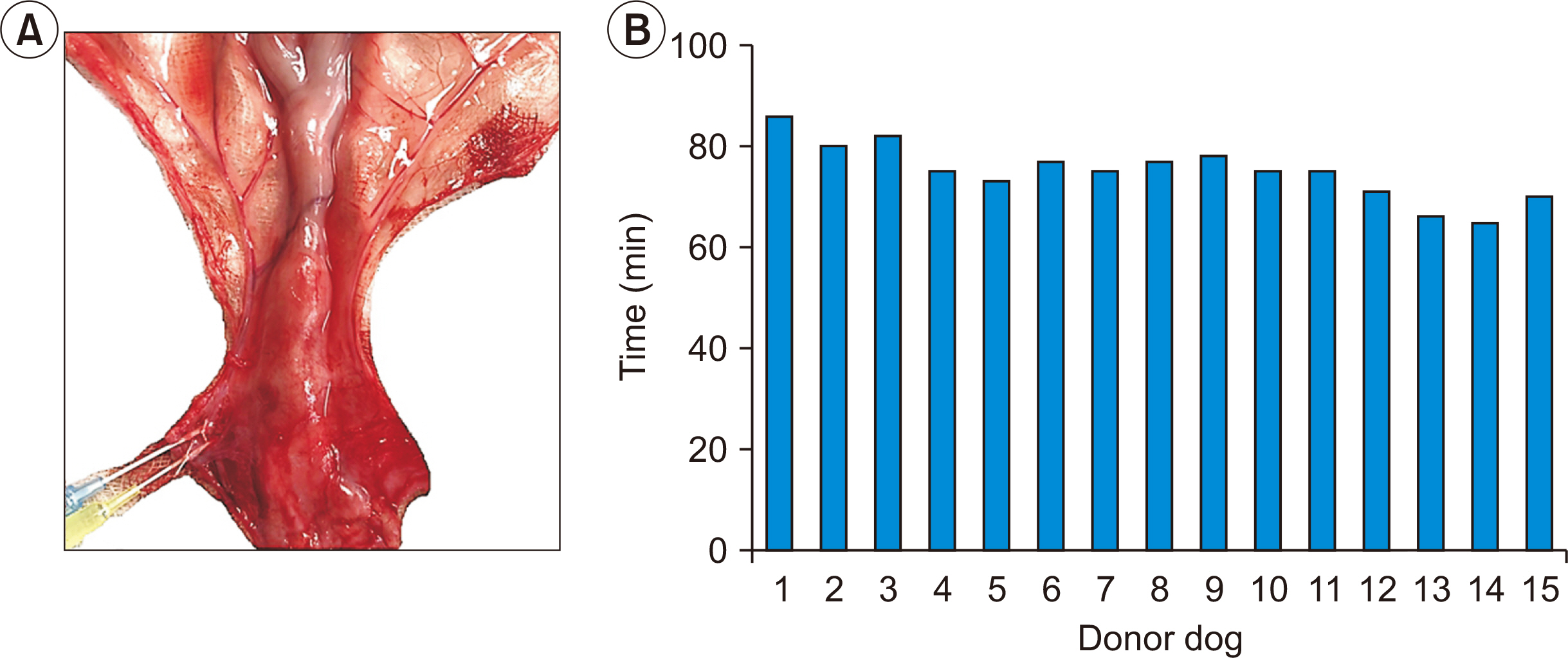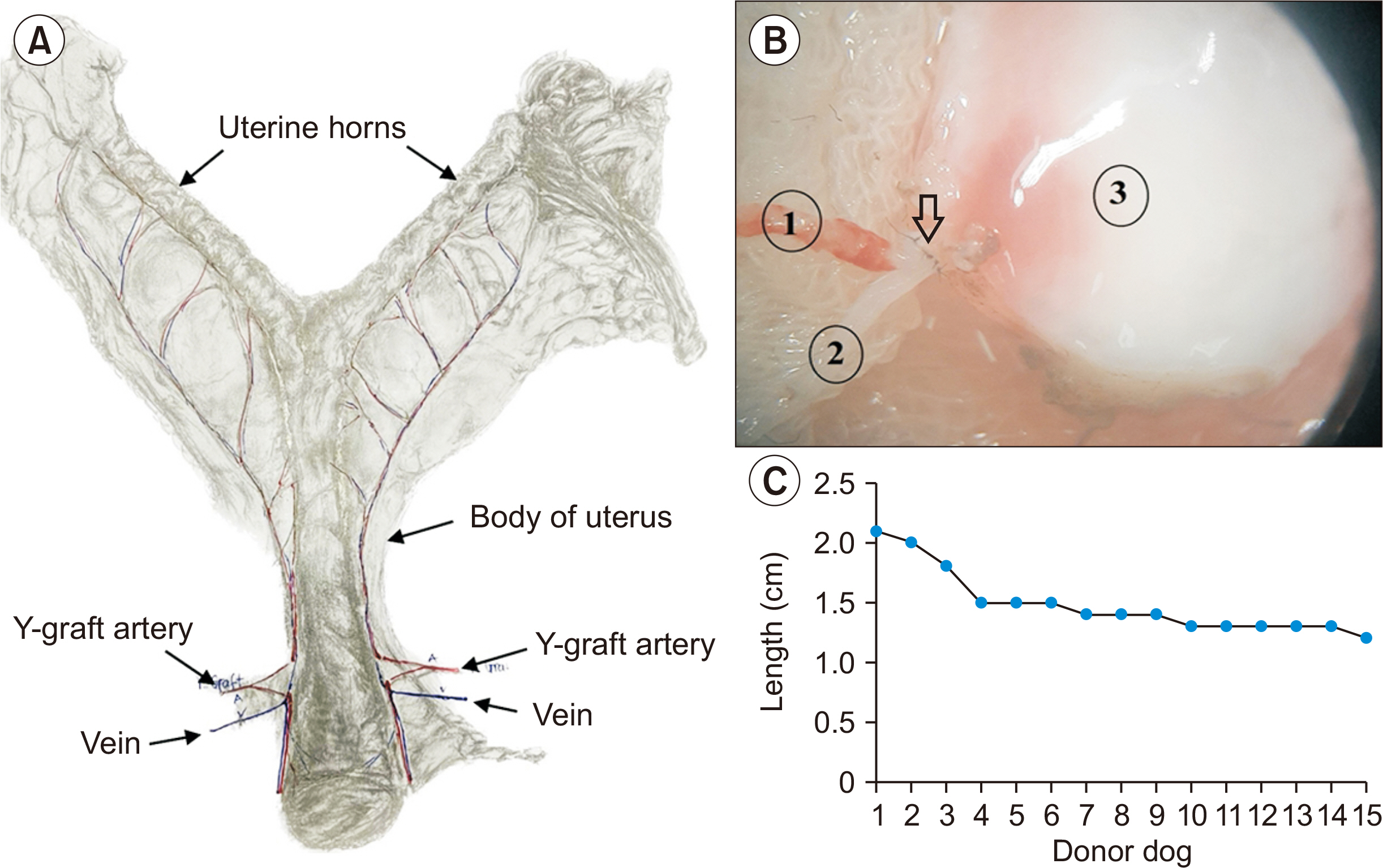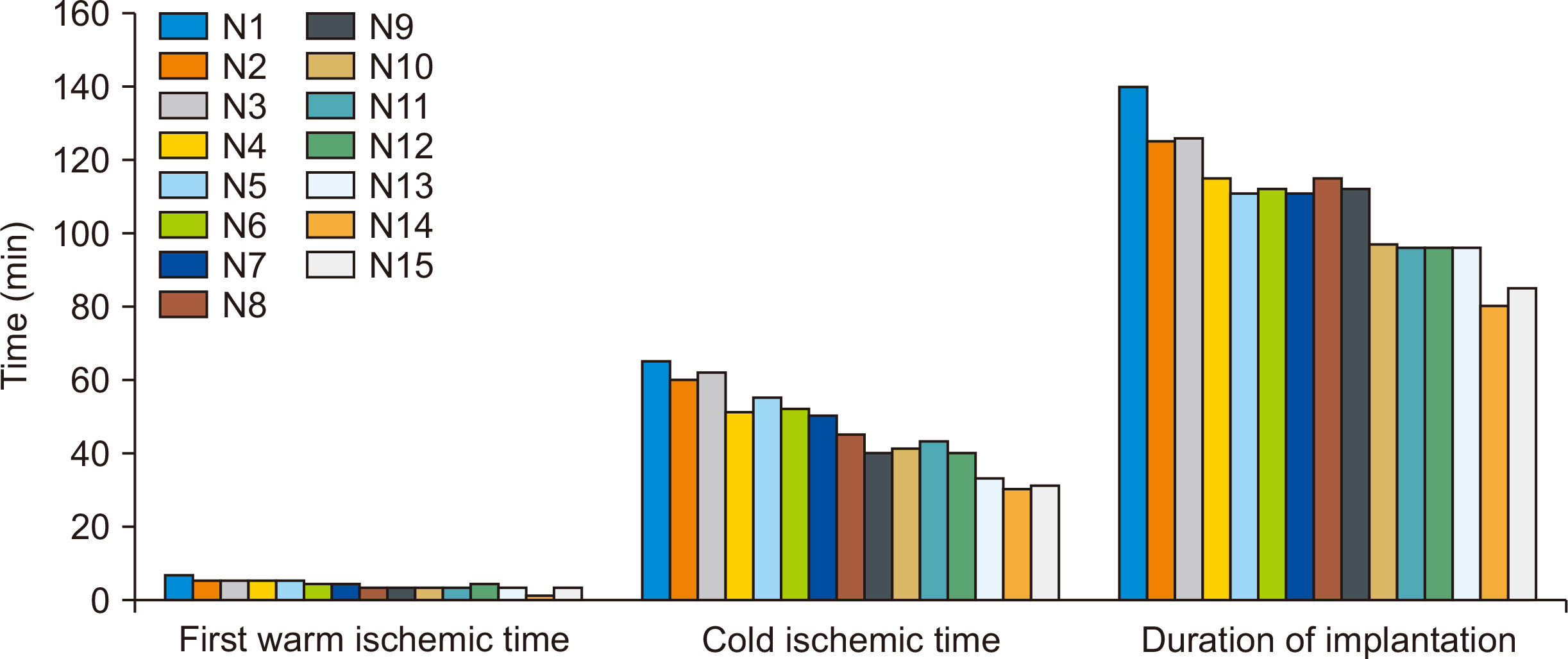Korean J Transplant.
2023 Jun;37(2):109-117. 10.4285/kjt.23.0019.
Anatomic characteristics and novel transplantation model of the canine uterus
- Affiliations
-
- 1Department of Practical and Experimental Surgery, Vietnam Military Medical University, Hanoi, Vietnam
- 2Plastic Surgery Center, National Burn Hospital, Vietnam Military Medical University, Hanoi, Vietnam
- 3Department of Cardiovascular Surgery, 108 Military Central Hospital, Hanoi, Vietnam
- 4Department of Obstetrics, 108 Military Central Hospital, Hanoi, Vietnam
- KMID: 2544115
- DOI: http://doi.org/10.4285/kjt.23.0019
Abstract
- Background
In Vietnam, the rate of absolute uterine factor infertility is increasing, but no study has been published on uterine transplantation. The present study was designed to comprehensively observe the canine uterine anatomy and to examine the possibility of using a living canine donor for uterine transplantation training and further research.
Methods
Ten female Vietnamese mixed-breed dogs were sacrificed for anatomical research, and 15 additional pairs were used to evaluate the novel uterine transplant model.
Results
The anatomic features of the canine uterus differed considerably from those of the human uterus, with the uterine vessels originating from branches of the pudendal vessels (also known as the vaginal vessels). The uterine vascular pedicle had a small diameter (1 to 1.5 mm for arteries and 1.2 to 2.0 mm for veins) and required manipulation under a microscope. To perform uterine transplantation, the donor specimen’s artery and vein lengths were successfully reconstructed by anastomosis between both sides of the vasculature using autologous Y-shaped subcutaneous veins. The living-donor uterine transplantation model constructed in this study was feasible, with the transplanted uterus surviving in 86.7% of cases (13/15).
Conclusions
Uterine transplantation was successfully performed in a Vietnamese canine living donor model. This model could be helpful in uterine transplantation training and improve the transplantation success rate in humans.
Keyword
Figure
Reference
-
1. Brannstrom M, Johannesson L, Dahm-Kahler P, Enskog A, Molne J, Kvarnstrom N, et al. 2014; First clinical uterus transplantation trial: a six-month report. Fertil Steril. 101:1228–36. DOI: 10.1016/j.fertnstert.2014.02.024. PMID: 24582522.
Article2. Brannstrom M, Johannesson L, Bokstrom H, Kvarnstrom N, Molne J, Dahm-Kahler P, et al. 2015; Livebirth after uterus transplantation. Lancet. 385:607–16. DOI: 10.1016/S0140-6736(14)61728-1. PMID: 25301505.
Article3. Favre-Inhofer A, Carbonnel M, Domert J, Cornet N, Chastant S, Coscas R, et al. 2022; Involving animal models in uterine transplantation. Front Surg. 9:830826. DOI: 10.3389/fsurg.2022.830826. PMID: 35284480. PMCID: PMC8904568.
Article4. Zhordania IF, Gotsiridze OA. 1964; Vital activity of the excised uterus and its appendages after their autotransplantation into omentum. Experimental research. Acta Chir Plast. 6:23–32.5. Eraslan S, Hamernik RJ, Hardy JD. 1966; Replantation of uterus and ovaries in dogs, with successful pregnancy. Arch Surg. 92:9–12. DOI: 10.1001/archsurg.1966.01320190011002. PMID: 5948103.
Article6. Barzilai A, Paldi E, Gal D, Hampel N. 1973; Autotransplantation of the uterus and ovaries in dogs. Isr J Med Sci. 9:49–52.7. Truta E, Pop I, Popa D, Ionescu M, Truta F. 1969; Experimental re- and transplantation of the internal female genital organs. Rom Med Rev. 13:53–8.8. Yonemoto RH, Du Sold WD, Deliman RM. 1969; Homotransplantation of uterus and ovaries in dogs: a preliminary report. Am J Obstet Gynecol. 104:1143–51. DOI: 10.1016/S0002-9378(16)34288-0. PMID: 5799618.9. Wall AE, Testa G, Axelrod D, Johannesson L. 2021; Uterus transplantation-questions and answers about the procedure that is expanding the field of solid organ transplantation. Proc (Bayl Univ Med Cent). 34:581–5. DOI: 10.1080/08998280.2021.1925064. PMID: 34456477. PMCID: PMC8366946.
Article10. Ozkan O, Dogan NU, Ozkan O, Mendilcioglu I, Dogan S, Aydinuraz B, et al. 2016; Uterus transplantation: from animal models through the first heart beating pregnancy to the first human live birth. Womens Health (Lond). 12:442–9. DOI: 10.1177/1745505716653849. PMID: 27638900. PMCID: PMC5373276.
Article11. Racho El-Akouri R, Kurlberg G, Brännström M. 2003; Successful uterine transplantation in the mouse: pregnancy and post-natal development of offspring. Hum Reprod. 18:2018–23. DOI: 10.1093/humrep/deg396. PMID: 14507815.
Article12. Groth K, Brannstrom M, Molne J, Wranning CA. 2010; Cyclosporine A exposure during pregnancy in mice: effects on reproductive performance in mothers and offspring. Hum Reprod. 25:697–704. DOI: 10.1093/humrep/dep470. PMID: 20085916.
Article13. Wranning CA, El-Akouri RR, Lundmark C, Dahm-Kahler P, Molne J, Enskog A, et al. 2006; Auto-transplantation of the uterus in the domestic pig (Sus scrofa): surgical technique and early reperfusion events. J Obstet Gynaecol Res. 32:358–67. DOI: 10.1111/j.1447-0756.2006.00426.x. PMID: 16882260.
Article14. Wranning CA, Marcickiewicz J, Enskog A, Dahm-Kahler P, Hanafy A, Brännström M. 2010; Fertility after autologous ovine uterine-tubal-ovarian transplantation by vascular anastomosis to the external iliac vessels. Hum Reprod. 25:1973–9. DOI: 10.1093/humrep/deq130. PMID: 20519245.
Article15. El-Akouri RR, Kurlberg G, Dindelegan G, Molne J, Wallin A, Brannstrom M. 2002; Heterotopic uterine transplantation by vascular anastomosis in the mouse. J Endocrinol. 174:157–66. DOI: 10.1677/joe.0.1740157. PMID: 12176655.
Article16. Wranning CA, Akhi SN, Diaz-Garcia C, Brannstrom M. 2011; Pregnancy after syngeneic uterus transplantation and spontaneous mating in the rat. Hum Reprod. 26:553–8. DOI: 10.1093/humrep/deq358. PMID: 21159686.
Article17. Miyauchi Y, Noda T, Miura N, Kikugawa T, Saika T. 2021; Venous reconstruction using a Y-shaped saphenous vein in kidney transplantation: a report of three cases. IJU Case Rep. 4:146–9. DOI: 10.1002/iju5.12266. PMID: 33977243. PMCID: PMC8088897.
Article18. Brucker SY, Brannstrom M, Taran FA, Nadalin S, Konigsrainer A, Rall K, et al. 2018; Selecting living donors for uterus transplantation: lessons learned from two transplantations resulting in menstrual functionality and another attempt, aborted after organ retrieval. Arch Gynecol Obstet. 297:675–84. DOI: 10.1007/s00404-017-4626-z. PMID: 29270725.
Article19. Chmel R, Novackova M, Janousek L, Matecha J, Pastor Z, Maluskova J, et al. 2019; Revaluation and lessons learned from the first 9 cases of a Czech uterus transplantation trial: four deceased donor and 5 living donor uterus transplantations. Am J Transplant. 19:855–64. DOI: 10.1111/ajt.15096. PMID: 30151893.
Article20. Feuillu B, Cormier L, Frimat L, Kessler M, Amrani M, Mangin P, et al. 2003; Kidney warming during transplantation. Transpl Int. 16:307–12. DOI: 10.1111/j.1432-2277.2003.tb00305.x. PMID: 12759721.
Article21. Dion L, Le Lous M, Nyangoh Timoh K, Levêque J, Arnaud A, Henri-Malbert C, et al. 2021; Single bilateral ovarian venous return in uterine transplant: validation in an orthotopic auto-transplant model in the Yucatan minipig. J Gynecol Obstet Hum Reprod. 50:102059. DOI: 10.1016/j.jogoh.2021.102059. PMID: 33421624.
Article22. Andraus W, Ejzenberg D, Santos RM, Mendes LR, Arantes RM, Baracat EC, et al. 2017; Sheep model for uterine transplantation: the best option before starting a human program. Clinics (Sao Paulo). 72:178–82. DOI: 10.6061/clinics/2017(03)08.
Article23. Favre-Inhofer A, Carbonnel M, Revaux A, Sandra O, Mougenot V, Bosc R, et al. 2018; Critical steps for initiating an animal uterine transplantation model in sheep: experience from a case series. Int J Surg. 60:245–51. DOI: 10.1016/j.ijsu.2018.11.017. PMID: 30481612.
Article24. Fageeh W, Raffa H, Jabbad H, Marzouki A. 2002; Transplantation of the human uterus. Int J Gynaecol Obstet. 76:245–51. DOI: 10.1016/S0020-7292(01)00597-5. PMID: 11880127.
Article25. Mäkikallio K, Tekay A, Jouppila P. 2004; Uteroplacental hemodynamics during early human pregnancy: a longitudinal study. Gynecol Obstet Invest. 58:49–54. DOI: 10.1159/000077914. PMID: 15087597.
Article
- Full Text Links
- Actions
-
Cited
- CITED
-
- Close
- Share
- Similar articles
-
- The anatomic characteristics of uterine and novel transplantation model: the experimental research
- Transcriptional and translational expression of calbindin-D9k in the duodenum, kidney and uterus of a female canine model
- Uterine expression of tight junctions in the Canine uterus
- Orthodontic treatment of palatally impacted canine
- The distance between the upper canine and the orbital plane in gnathostatic model of Koreans with normal occlusion






